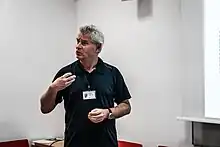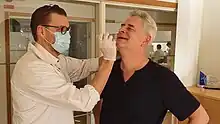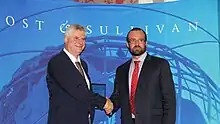Prof. Mikael Kubista | |
|---|---|
 | |
| Born | 13 August 1961 |
| Nationality | Swedish |
| Citizenship | Swedish |
| Alma mater |
|
| Known for |
|
| Awards |
|
| Scientific career | |
| Fields | Biochemistry |
| Institutions |
|
Mikael Kubista (born 13 August 1961) is Czech-born Swedish chemist and entrepreneur. He is one of the most cited researchers globally, ranking among the top 2%, publishing more than 200 research papers in the field of molecular diagnostics. Since 2007, he is serving as a Professor of Chemistry and Head of the Department of Gene Expression Profiling at the Biotechnology Institute, Czech Academy of Sciences in the Czech Republic.
Kubista is known for his contribution for the advancement of quantitative real-time PCR (qPCR), being among the early innovators.[1][2]
Kubista was a member of the research team at Astra Hässle, where they focused on investigating Omeprazole, an inhibitor of K+/H+-ATPase. The drug is now marketed under the trade names Losec and Nexium, widely prescribed medications for the treatment of gastric ulcer.[3] Additionally, Kubista is the Chairman of the Board of MultiD Analyses AB and the founder of TATAA Biocenter, which was recognized as the 'Best Nucleic Acid Analysis Service provider – Europe' by Global Health & Pharma.[4][5][6][7]
Early life
Kubista was born to his medical doctor father in the former Czechoslovakia in 1961. His father received a scholarship and relocated to Sweden. At the age of 7 in 1968, Kubista went to Sweden to visit his father. However, on that very day, Russia invaded Czechoslovakia in the so called Warsaw Pact invasion of Czechoslovakia, and as a result, the family decided to stay making Sweden their new home.[8]
Education
He completed his undergraduate studies at University of Gothenburg, earning a B.Sc. degree in chemistry in 1984. He then pursued a Licentiate in Physical Chemistry at the Institute of Chemistry and Chemical Engineering, Chalmers University of Technology in Göteborg, which he completed in 1986. Kubista obtained his Ph.D. in chemistry from Chalmers University of Technology. Following his doctoral studies, he conducted postdoctoral research at institutions such as La Trobe University in Melbourne, Australia, and Yale University in New Haven, US.[7][3] Additionally, he has held visiting professor positions at various universities, including the University of Maryland in College Park, US, in June 2000, and the University of A Coruña in Spain, during September–November 2003 and July 2006 to June 2007. Since 2007, Kubista is serving as an adjunct professor at the Institute of Biotechnology, Czech Academy of Sciences.[9][10][8]
Career
Academic career

Kubista began his academic career in 1991 as an Assistant Professor in the Department of Physical Chemistry at Chalmers University of Technology. From 1993 to 1997, he served as an Associate Professor in the Department of Biochemistry at the same institution. Following this, he held the position of Professor in the Department of Biochemistry at Chalmers University of Technology from 1997 to 2006. Since 2007, Kubista possessed the position of Head of the Department of Gene Expression at the Institute of Biotechnology, BIOCEV, Czech Academy of Sciences.
Entrepreneurial activities

In 1998 Kubista founded LightUp Technologies AB after his research finding of lightUp probes,[2] a company that specializes in the development of real-time PCR tests for human infectious diseases.[11][4] Three years later In 2001, Kubista's research led to the establishments of MultiD Analyses AB, develops GenEx software for gene expression data analysis and TATAA Biocenter, which became recognized as a center of excellence in qPCR and gene expression analysis.[11][4] The company became well-known for its qPCR training services globally and its provision of qPCR services, particularly in Europe. TATAA Biocenter was the first laboratory in Europe to obtain flexible ISO 17025 accreditation and also was the first to provide COVID tests at the onset of the pandemic.[12][6] In 2014 Kubista pioneered the implementation of non-invasive prenatal testing (NIPT) in Sweden and subsequently founded Life Genomics AB.[4] In 2020, Kubista co-founded SimSen Diagnostics, a company focused on developing technology for liquid biopsy analyses.[7][3][5]
Advisorial roles and memberships
Kubista holds several positions and advisory roles within the scientific and biotechnology communities including: Roche, ThermoFisher, Qiagen, Bio-Rad, and RealSeq Biosciences. He is also a member of the Scientific Advisory Council of Genetic Engineering News.[13][1]
Kubista has also been actively involved in supporting the establishment of modern molecular diagnostics in developing countries. Since 1999, he has served as an advisor to UNESCO, providing guidance and assistance to countries such as Egypt, Iran, Grenada, and Ghana.[3][8]
Kubista is an expert advisor for the European Commission Research Directorate General. He also works as a special consultant in the Life Science field for AFRY and Pharma Relations. Kubista advises the United Nations Educational Scientific and Cultural Organization (UNESCO) and is part of the scientific advisory board for the International Biotechnology Research in Tripoli, Libya, under UNESCO.[8][14] He has editorial roles in scientific publications, including being an editor for Scientific Reports at the Nature Publishing Group and serving as an editor for Molecular Aspects of Medicine[3] and the International Journal of Oncology.[15]
Major research accomplishments and publications

Kubista is one of the most cited researchers, ranking within the top 2%, with a substantial cumulative citation count of 36,000 for his more than 200 research papers.[7]
In 1991, he established his own research group to investigate DNA-ligand interactions.[10] Their studies focused on the RecA-catalyzed strand exchange process, yielding crucial insights into how DNA strands exchange during homologous recombination and contributing to the current understanding in the field. His team introduced the Two-tailed PCR method, known for its sensitivity and specificity in the analysis of short nucleic acids.[16][4] He also devised methods for analyzing multidimensional data, which served as the foundational basis for the establishment of MultiD Analyses AB.[3][17]
Kubista co-authored the MIQE guidelines for RT-qPCR analysis, which have received significant citations and hold significant importance in the field.[7][10]
Major findings and publications

- Studied and identified numerous biologically significant chromophores and a variety of dyes commonly used as biomolecule labels like: tryptophan, DAPI, fluorescein,[18] thiazole orange, and BEBO. The research findings are prominently featured in the Molecular Probes catalogue.[19][2]
- Explained the intricate process of DNA strand exchange in homologous recombination. Which the results have been published in the widely recognized textbook "Biochemistry" authored by Mathew, Van Holde, and Ahern (3rd edition, 2000, Benjamin Cummings – ISBN 0-8053-3066-6).[20]
- Applying Widlund experiment, identified specific nucleosome positioning sequences which is extensively discussed in the book "Chromatin" authored by A. Wolfe (1999, Academic Press – ISBN 0-12-761914-3)[11][20]
- Uncovered new mechanism of oncogene activation involving the formation of internal G-quadruplexes.[21] The discovery was featured in the Textbook of Biochemistry with Clinical Correlations, 5th edition, authored by Devlin (2002, John Wiley & Sons Inc – ISBN 0-471-41136-1), as well as the Encyclopedia of Molecular Medicine (2002, John Wiley & Sons Inc – ISBN 0-471-37494-6).[3][20]
- Designed a probe that exhibit luminescence upon binding to specific nucleic acids.[22][23]
- Initiated the field of analyzing gene expression at the level of individual cells and subcellular compartments.[24][20]
- Revealed the occurrence of horizontal transfer of mitochondria within living organisms.[20][25]
Awards and recognition

- In 2021 Kubista's organization, TATAA was on Sweden Technology Fast 50 list[5]
- In 2019, Global Health & Pharma recognized and awarded TATAA as the "Best Nucleic Acid Analysis Service Provider – Europe."[4][14]
- In 2013 TATAA Biocenter was honored with the Frost & Sullivan Award for Customer Value Leadership for their outstanding services in analyzing genetic material [17][14]
- In 2012, Pioneer of the year in western Sweden[14]
- In 1996, won Innovation Cup in western Sweden for the LightUp probes[14]
References
- 1 2 "Bringing qPCR testing into the 21st century: an interview with Mikael Kubista". thermofisher. Retrieved 28 December 2023.
- 1 2 3 "Biomolecular Detection and Quantification" (PDF). gene-quantification. Retrieved 2 January 2024.
- 1 2 3 4 5 6 7 "M. Kubista, PhD – Editorial Board – Molecular Aspects of Medicine – Journal – Elsevier". journals.elsevier.com. Retrieved 2023-12-28.
- 1 2 3 4 5 6 "Mikael Kubista". BioTech Pharma Summit. Retrieved 2023-12-28.
- 1 2 3 "TATAA Biocenter – ett av Sveriges snabbast växande teknikföretag". Mynewsdesk (in Swedish). 2021-11-19. Retrieved 2023-12-28.
- 1 2 "What's next for Gothenburg life science profile, Mikael Kubista?". sahlgrenskasciencepark.se. Retrieved 2023-12-28.
- 1 2 3 4 5 "mikael-kubista". qiagen.com. Retrieved 2023-12-28.
- 1 2 3 4 Tachibana, Chris. "Profile, Mikael Kubista" (PDF). squarespace. Retrieved 2 January 2024.
- ↑ "Academy of Europe: CV". ae-info.org. Retrieved 2023-12-28.
- 1 2 3 "Scientific Advisory Board". Technology Networks. Retrieved 2023-12-28.
- 1 2 3 "Mikael Kubista". publicationslist. Retrieved 28 December 2023.
- ↑ "TATAA Biocenter to offer GLP services to developers of cell and gene therapies across the world". naringsliv. Retrieved 28 December 2023.
- ↑ "RealSeq: Mikael Kubista". 360dx. Retrieved 28 December 2023.
- 1 2 3 4 5 "Academy of Europe: Kubista Mikael". ae-info.org. Retrieved 2023-12-28.
- ↑ "International Journal of Oncology". spandidos-publications. Retrieved 2 January 2024.
- ↑ "Two-tailed RT-qPCR: a novel method for highly accurate miRNA quantification". academic. Retrieved 2 January 2024.
- 1 2 "ORCID". orcid.org. Retrieved 2023-12-28.
- ↑ "Absorption and fluorescence properties of fluorescein". sciencedirect. Retrieved 2 January 2024.
- ↑ "Absorption and fluorescence properties of fluorescein". scholar.google.com. Retrieved 2023-12-28.
- 1 2 3 4 5 danielduran.cz, Design: Martin Kolerus, Code: Daniel Duran. "prof. Dr. Mikael Kubista, Ph.D." biocev.eu. Biocev. Retrieved 2023-12-28.
{{cite web}}: CS1 maint: multiple names: authors list (link) - ↑ "DNA tetraplex formation in the control region of c-my". academic. Retrieved 2 January 2024.
- ↑ "Light-up probes: thiazole orange-conjugated peptide nucleic acid for detection of target nucleic acid in homogeneous solution". scholar.google.com. Retrieved 2023-12-28.
- ↑ "Light-Up Probes: Thiazole Orange-Conjugated Peptide Nucleic Acid for Detection of Target Nucleic Acid in Homogeneous Solution". sciencedirect. Retrieved 2 January 2024.
- ↑ "Gene expression profiling in single cells from the pancreatic islets of Langerhans reveals lognormal distribution of mRNA levels". genome. Retrieved 2 January 2024.
- ↑ "Horizontal transfer of whole mitochondria restores tumorigenic potential in mitochondrial DNA-deficient cancer cells". scholar.google.com. Retrieved 2023-12-28.